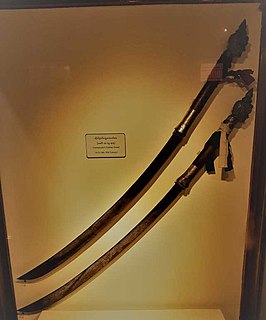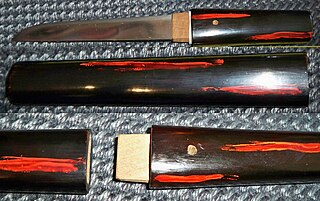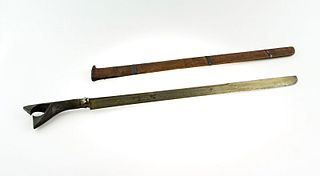
Dha is the Burmese word for "knife" similar term to daab or darb in Thai language for a single edge sword. The term dha is conventionally used to refer to a wide variety of knives and swords used by many people across Southeast Asia, especially present-day Myanmar (Burma), Thailand, Yunnan, Laos, Cambodia and Vietnam.

A shotel is a curved sword originating in Ethiopia and Eritrea. The curve on the blade varies from the Persian shamshir, adopting an almost semicircular shape. The blade is flat and double-edged with a diamond cross-section. The blade is about 40 inches (1,000 mm) in total length and the hilt is a simple wooden piece with no guard. The shotel was carried in a close fitting leather scabbard.

The Flyssa is a traditional edged weapon of the Kabyles, a Berber tribe of Algeria, produced during the 19th century and earlier. These weapons have blades of various sizes from 12 to 38 inches, and can be classed as varying between long knives and full-sized swords. Whatever their size, flyssas are characterized by narrow, straight-backed, single-edged blades, which come to an acute point. The blades of sword-sized flyssas often widen gradually around the point of percussion, which enhances their cutting ability. The blades are often decorated with chiselled patterns, which are sometimes inlaid. The hilt has no guard and the junction between blade and hilt is made by a metal bolster. The distal part of the hilt is almost always of wood covered with brass, usually decorated with repoussé and chasing, and has a characteristic downturned projection forming the snout of a stylised animal head at the 'pommel' end.

The yoroi-dōshi (鎧通し), "armor piercer" or "mail piercer", is one of the traditionally made Japanese swords (nihontō) that were worn by the samurai class as a weapon in feudal Japan.

A kaiken (懐剣) is a 20–25 cm (8–10 in) long, single or double-edged dagger without ornamental fittings housed in a plain mount.
George Cameron Stone was a well-known American arms collector and author as well as an American mining engineer and metallurgist. He authored a glossary of the antique weapons of the world that remains one of the most comprehensive works ever written on the subject.
The Moplah sword is a sword used by the Muslim population in the Malabar Coast in southwestern India.

Kusari gusoku (鎖具足) is the Japanese term for mail armour. Kusari is a type of armour used by the samurai class and their retainers in feudal Japan. When the word kusari is used in conjunction with an armoured item it usually means that the kusari makes up the majority of the armour defence.

Niabor is a curved sword from Borneo, a characteristic weapon of the Sea-Dayaks.

The Pandat is the war sword of the Dayak people of northwest Borneo and is never used as a tool. On October 18, 2016, this weapon was featured in season 3 episode 9 of the American bladesmithing competition series Forged in Fire.
Parang Nabur is a sword that originates from Banjarmasin, South Kalimantan, Indonesia. Most of this sword is made during the Banjarmasin Sultanate period in the 19th century.

Sikin Panjang is a sword originated from northern Sumatra, Indonesia.

Palitai is the traditional knife of the Mentawai people, originating from the Mentawai Islands off West Sumatra, Indonesia.

Wedung is a traditional large knife of the Javanese people and the Balinese people originating from Indonesia.

Kurabit is a traditional shield originating from the Mentawai Islands off the coast of West Sumatra, Indonesia.

A Piso Halasan is a traditional sword of the Batak people from North Tapanuli Regency, North Sumatra, Indonesia.
Alamang or Sonri is a sacred sword or cutlass of the Bugis and Makassarese people in Sulawesi, Indonesia.

The Chimalli was the traditional defensive armament of the indigenous states of Mesoamerica. These shields varied in design and purpose. The Chimali was also used while wearing special headgear.
The Jamdhar-Katari is the traditional dagger of the Hindu Kush strains in Afghanistan.

Katapu or Kalapu is a traditional war cap or helmet used by Dayaks of Borneo. Katapu Kaloi is a sea dayak war cap, made by sewing large fish scales on cap made from a bast-like material.
This page is based on this
Wikipedia article Text is available under the
CC BY-SA 4.0 license; additional terms may apply.
Images, videos and audio are available under their respective licenses.















